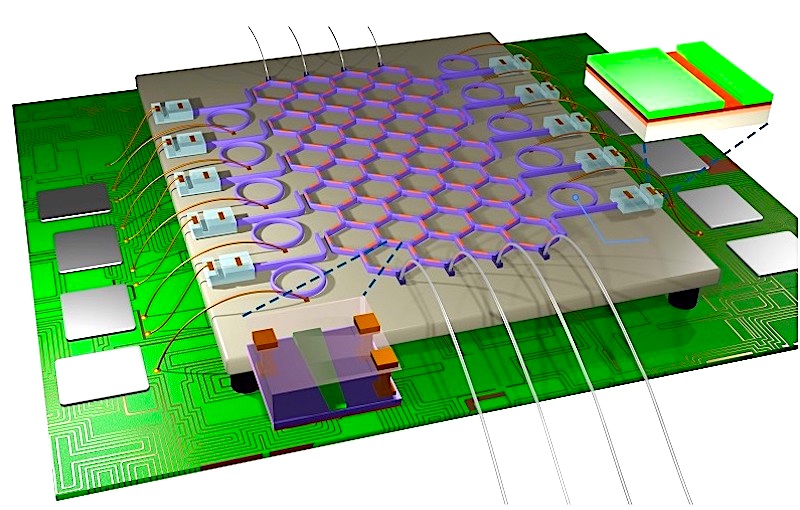 Conventional Computers have been proved inefficient in various problems such as the pattern recognition in big data (video, image and sound). Moreover, conventional computers cannot address problems with exponential complexity. In order to exceed this obstacle, neuromorphic and quantum computers have been investigated both theoretically and experimentally. Until now, these two important paradigms of unconventional computing have followed parallel paths. PROMETHEUS’ vision is to shatter the boundaries between quantum and neuromorphic photonic processing and merge them into a uniform integrated platform. In particular, the PROMETHEUS’ photonic integrated chip (PIC) will be based on a highly dense silicon on insulator (SOI) Field Programmable Photonic Gate Array (FPPGA) synaptic layer, strengthened by nearly-zero power-consuming non-volatile barium titanate (BTO) phase shifters and co-integrated III-V lasers, that will form an ultra-fast spiking neural layer. Sophisticated packaging, will provide a disruptive, yet robust device able to unravel large-scale neuromorphic-quantum implementations, offering unprecedentedly low power consumption, processing speed and versatility to adapt to a wide pallet of applications.
Conventional Computers have been proved inefficient in various problems such as the pattern recognition in big data (video, image and sound). Moreover, conventional computers cannot address problems with exponential complexity. In order to exceed this obstacle, neuromorphic and quantum computers have been investigated both theoretically and experimentally. Until now, these two important paradigms of unconventional computing have followed parallel paths. PROMETHEUS’ vision is to shatter the boundaries between quantum and neuromorphic photonic processing and merge them into a uniform integrated platform. In particular, the PROMETHEUS’ photonic integrated chip (PIC) will be based on a highly dense silicon on insulator (SOI) Field Programmable Photonic Gate Array (FPPGA) synaptic layer, strengthened by nearly-zero power-consuming non-volatile barium titanate (BTO) phase shifters and co-integrated III-V lasers, that will form an ultra-fast spiking neural layer. Sophisticated packaging, will provide a disruptive, yet robust device able to unravel large-scale neuromorphic-quantum implementations, offering unprecedentedly low power consumption, processing speed and versatility to adapt to a wide pallet of applications.
PROMETHEUS’ multi-purpose photonic platform will be suitable for the exploration of emerging concepts such as spiking networks, reservoir computing, convolutional optical networks and quantum neural networks; aiming to address two key industry-driven applications: high-speed image processing (Mframes/sec) for biomedical/industrial applications (cytometry/laser scanning) and optical signal processing at the network’s edge (signal equalization). Moving a step further, PROMETHEUS’ PIC will be also utilized as a physical root of trust, unlocking its use as a quantum random number generator (QRNG) module and as a cyber-secure photonic physical unclonable function (PUF). These two operations will provide a pivotal advantage to PROMETHEUS’ modules: to act as neuromorphic processors and at the same time, to provide hardware-based authentication and security features derived from quantum key generation.
The University of West Attica participates with the Parallel and Distributer Systems and Networks Lab (PDSN) and is responsible for the design of neuromorphic circuits and the integration with high-speed digital electronics. PDSN will also take over the evaluation of PROMETHEUS chips in real life application such as optical communications and edge computing.
Project Τitle: PROMETHEUS (PROgraMmable integrated photonic nEuromorphic and quanTum networks for High–speed imaging, communications and sEcUrity applicationS)
Project Duration: 1/9/2022-30/8/2025
Project URL: https://prometheus-he.eu/
Project Framework & Funding: This program has been funded by European Commission with almost 4 million euros in the context of the action: CL4-2021-DIGITAL EMERIGNG-01-07.
Scientific coordinator (UNIWA): Adonis Bogris
Consortium – Partners:
- University of West Attica, Department of Informatics and Computer Engineering
- University of the Aegean – Department of Information and Communication Systems Engineering
- iPRONICS (Spain),
- Technical University of Denmark
- Ghent University (Belgium)
- QTI (Italy)
- CEA (France)
- Fraunhofer IZM (Germany)
- Scintil Photonics (France)
- IBM Research (Switzerland)
- Lumiphase (Switzerland)
- Inivation (Switzerland)
Research Publications / Results / Patents
[1] K. Sozos, A. Bogris, P. Bienstman, G. Sarantoglou, S. Deligiannidis, and C. Mesaritakis, “High-speed photonic neuromorphic computing using recurrent optical spectrum slicing neural networks,” Commun. Eng., vol. 1, no. 1, p. 24, Oct. 2022, doi: 10.1038/s44172-022-00024-5.
[2] D. Dermanis, A. Bogris, P. Rizomiliotis, and C. Mesaritakis, “Photonic Physical Unclonable Function based on Integrated Neuromorphic Devices,” J. Light. Technol., 2022, doi: 10.1109/JLT.2022.3200307.












